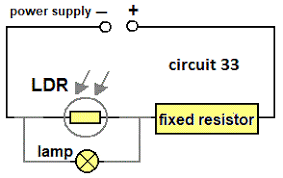
Circuit Devices
LDR is short for Light Dependence Resistor
An LDR is a resistor that is dependent on the intensity of light.
In bright light, the resistance falls
In darkness, the resistance is highest
They have lots of applications including automatic night lights, outdoor lighting and burglar detectors
The resistance of a Thermistor depends on Temperature
A thermistor is a temperature dependent resistor
In hot conditions, the resistance drops
In cool conditions, the resistance goes up
Thermistors make useful temperature detectors, temperature sensors and electronic thermostats
You can use LDRs and Thermistors in Sensing Circuits
Sensing circuits can be used to turn on or increase the power to components depending on the condition that they are in
The circuit on the right is a sensing circuit used to control a fan in a room
The fixed resistor and the fan will always have the same potential difference across them
The pd of the power supply is shared out between the thermistor and the loop made up of the fixed resistor and the fan according to their resistances-the bigger a component’s resistance, the more of the pd it takes
As the room gets hotter, the resistance of the thermistor decreases and it takes a smaller share of the pd from the power supply. So the pd across the fixed resistor and the fan rises, making the fan go faster

You can also connect the components across the variable resistor instead.
For examples, if you connect a bulb in parallel to an LDR, the pd across both the LDR and the bulb will be high when it’s dark and the LDR’s resistance is high. The greater the pd across a component, the more energy it gets. So a bulb connected across an LDR would get brighter as the room got darker

Circuit Devices
LDR is short for Light Dependence Resistor
An LDR is a resistor that is dependent on the intensity of light.
In bright light, the resistance falls
In darkness, the resistance is highest
They have lots of applications including automatic night lights, outdoor lighting and burglar detectors
The resistance of a Thermistor depends on Temperature
A thermistor is a temperature dependent resistor
In hot conditions, the resistance drops
In cool conditions, the resistance goes up
Thermistors make useful temperature detectors, temperature sensors and electronic thermostats
You can use LDRs and Thermistors in Sensing Circuits
Sensing circuits can be used to turn on or increase the power to components depending on the condition that they are in
The circuit on the right is a sensing circuit used to control a fan in a room
The fixed resistor and the fan will always have the same potential difference across them
The pd of the power supply is shared out between the thermistor and the loop made up of the fixed resistor and the fan according to their resistances-the bigger a component’s resistance, the more of the pd it takes
As the room gets hotter, the resistance of the thermistor decreases and it takes a smaller share of the pd from the power supply. So the pd across the fixed resistor and the fan rises, making the fan go faster

You can also connect the components across the variable resistor instead.
For examples, if you connect a bulb in parallel to an LDR, the pd across both the LDR and the bulb will be high when it’s dark and the LDR’s resistance is high. The greater the pd across a component, the more energy it gets. So a bulb connected across an LDR would get brighter as the room got darker

 Knowt
Knowt
